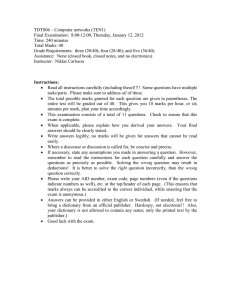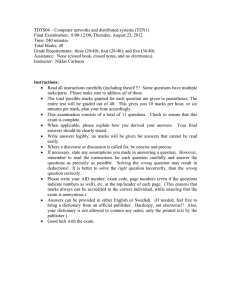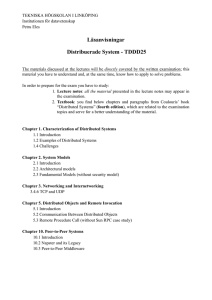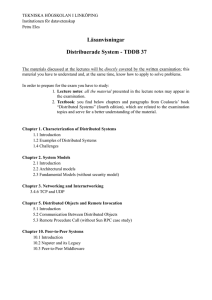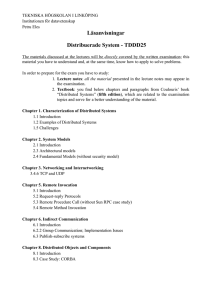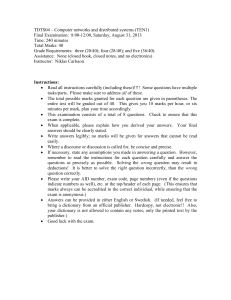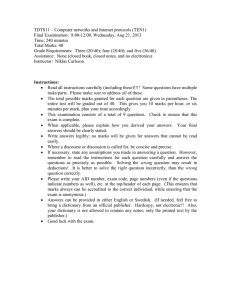TDTS04 – Computer networks and distributed systems (TEN1)
advertisement
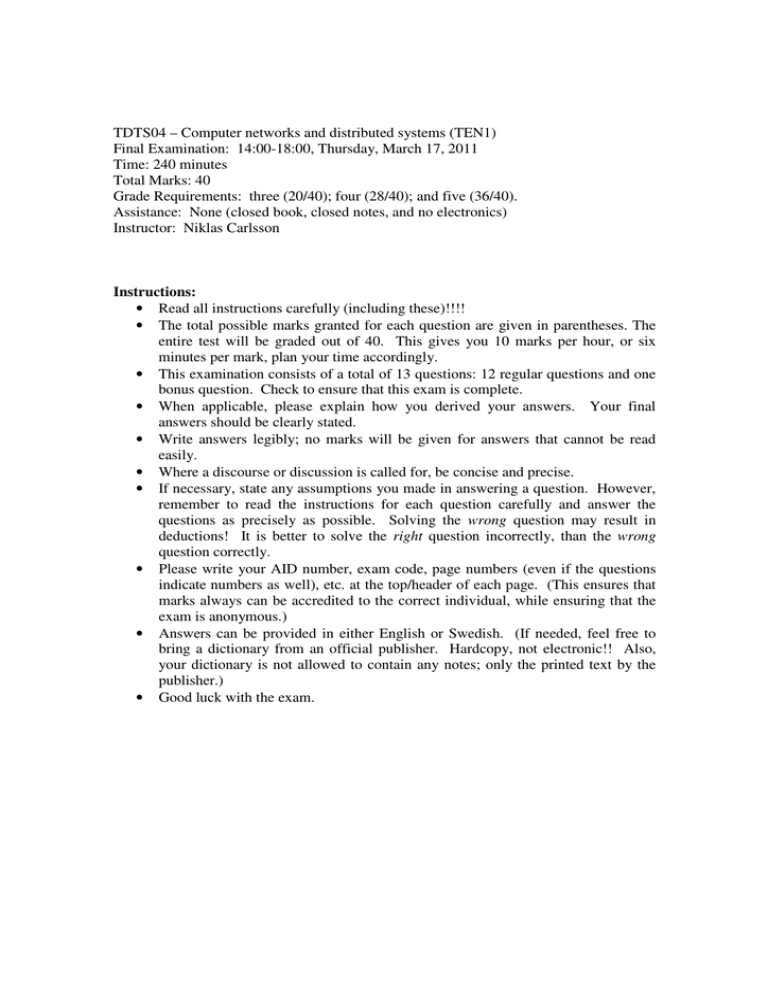
TDTS04 – Computer networks and distributed systems (TEN1) Final Examination: 14:00-18:00, Thursday, March 17, 2011 Time: 240 minutes Total Marks: 40 Grade Requirements: three (20/40); four (28/40); and five (36/40). Assistance: None (closed book, closed notes, and no electronics) Instructor: Niklas Carlsson Instructions: • Read all instructions carefully (including these)!!!! • The total possible marks granted for each question are given in parentheses. The entire test will be graded out of 40. This gives you 10 marks per hour, or six minutes per mark, plan your time accordingly. • This examination consists of a total of 13 questions: 12 regular questions and one bonus question. Check to ensure that this exam is complete. • When applicable, please explain how you derived your answers. Your final answers should be clearly stated. • Write answers legibly; no marks will be given for answers that cannot be read easily. • Where a discourse or discussion is called for, be concise and precise. • If necessary, state any assumptions you made in answering a question. However, remember to read the instructions for each question carefully and answer the questions as precisely as possible. Solving the wrong question may result in deductions! It is better to solve the right question incorrectly, than the wrong question correctly. • Please write your AID number, exam code, page numbers (even if the questions indicate numbers as well), etc. at the top/header of each page. (This ensures that marks always can be accredited to the correct individual, while ensuring that the exam is anonymous.) • Answers can be provided in either English or Swedish. (If needed, feel free to bring a dictionary from an official publisher. Hardcopy, not electronic!! Also, your dictionary is not allowed to contain any notes; only the printed text by the publisher.) • Good luck with the exam. TDTS04 – Computer networks and distributed systems Final Exam: 14:00-18:00, Thursday, March 17, 2011 1) Question: Protocol stack (4) (a) Draw a picture of the protocol stack used for the Internet. (b) In which layer is UDP implemented? (c) In which layer is BGP implemented? (d) Which layers of the protocol stack does a router typically implement? 2) Question: Encapsulation (4) Show the link-layer frame for a small HTTP request (that fits in a single frame) when it is just to be passed down to the physical layer at the requesting host. You do not have to show all the details of the different headers; however, you should (i) explain what protocols the different headers are associated with, and (ii) provide the address information associated with the source and destination fields for each of the different headers. You can assume that the source machine uses Ethernet, have a MAC address AA:AA:AA:AA and an IP address 111.111.111.111; the MAC and IP addresses of the closest router is BB:BB:BB:BB and 111.111.111.222; and finally, the MAC and IP addresses of the HTTP server is CC:CC:CC:CC and 222.222.222.222. 3) Question: BitTorrent (3) One of the more important mechanisms in BitTorrent is the rarest-first policy. Please explain what this policy does, what it achieves, and why it is important for the success of BitTorrent. 4) Question: Flow control vs. congestion control (2) What is the difference between flow control and congestion control? 5) Question: TCP (4) Consider a file transfer between two machines A and B using TCP. Assume that machine A initiates the connection and transfers a file that would fill up a total of 20 packets. Further assume that the connection will not have any losses and the machines have a round trip time (RTT) of 25ms. How long will it take to set up the connection, transfer all the data, and then tear down the connection? (For simplicity, you can ignore the transmission times and assume that the client initiates the teardown as soon as the file is fully downloaded. Hint: It will help to draw a figure with all the message transfers between the nodes.) 6) Question: TCP fairness (3) Please explain how the throughput of two TCP flows with the same round trip time (RTT) converges to the same value as they compete for the bandwidth of a shared link. (Again, an illustration will help.) 2 TDTS04 – Computer networks and distributed systems Final Exam: 14:00-18:00, Thursday, March 17, 2011 7) Question: Forwarding vs routing (2) What is the difference between forwarding and routing in the IP layer? 8) Question: Distance vector routing (4) Consider a node A with neighbors B, C, and D. Node A currently has the distance table below. Assume that it receives an updated distance vector from neighbor B which looks as follows [∞, 0, 1, 1, 8, 9, 2]. Please update the table below, including A’s own distance vector. Second, assume that poison reverse is implemented, and explain what information the node sends to each its neighbors (after the table has been updated). Destination A B C D E F G A (via) 0 (A) 1 (B) 1 (C) 1 (D) 8 (C) 9 (C) 10 (C) Costs B C D ∞ ∞ ∞ 0 1 1 8 9 10 1 0 1 7 8 9 1 1 0 8 9 10 9) Question: Multicast delivery (2) Please explain the main differences between source-based multicast trees and shared multicast trees. Please discuss this from the basis of a video conference with 10 users; each located in different subnets. 10) Question: Replicated service (4) Consider a replicated service. In class we discussed how the load could be distributed across replicas. (a) Please explain when it may be beneficial to evenly balance the load across replicas. (b) Please explain why it sometimes may be beneficial to place as much load as possible on a few machines. 11) Question: Corba (4) In the last lab you used Corba’s callback functionality for asynchronous method invocations. (a) Please explain how a callback is implemented in Corba. A figure may be helpful here. (b) Please explain the advantage of asynchronous calls compared to synchronous calls. 3 TDTS04 – Computer networks and distributed systems Final Exam: 14:00-18:00, Thursday, March 17, 2011 12) Question: Lamport’s clock (4) Assume that you have three processes p1, p2, and p3. These processes each have their own clock. The clocks run at different rates: 6, 8, and 10, respectively, where the rates are the number of time units it takes to transfer a message from one process to the next. An example is illustrated in the figure below. Please complete the figure below and explain how the processes would adjust their clocks if using Lamport’s logical clocks. 0 0 0 6 8 10 13) Bonus Question: Message integrity and authentication (4) Consider a sender Alice who wants to send a large message over the network to a receiver Bob in a way that allow Bob to verify that the message was sent by Alice and nobody else (including Trudy) modified the message. You can assume that Alice and Bob have “trusted” copies of each other’s public keys, as well as a common hash function (e.g., SHA-1). However, they do not have a shared secret key. Further, assume that it is a large message and Alice and Bob do not want to use public key cryptography for the message delivery itself. Instead they want to use the message authentication (MAC) approach described in the textbook and in class (which requires the use of a common hash function plus a shared secret key). Please support your solution with a figure. Good luck! 4
